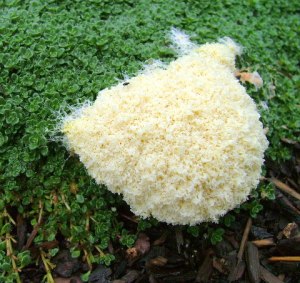 APPEARANCE
APPEARANCE
At first glance, you may think your neighbor’s dog has vomited on your lawn. These flattened slimy or spongy masses, up to 2 feet in diameter, are living organisms known as slime molds. They may be white, yellow, pink or tan and often appear during rainy periods. Slime molds can actually travel several feet a day! And despite their name, they are not related to molds or fungi.
LIFE HISTORY
Slime molds feed on microscopic organisms that live in rotting plant matter. They are found on lawns, wood bark mulches, and even on the decaying leaves in your gutters. Damp weather encourages their spores to germinate and grow. When conditions dry out, puffball-like structures produce a new generation of spores. The slime mold will then break down, leaving its spores behind as a brown powder.
WHAT TO DO
Although they don’t feed on your plants, any slime mold covering and shading a plant should be removed. No pesticides are labeled for use on slime molds. Instead, you can rake them up, bag them for disposal or disperse them with a strong jet from the hose. You can also do nothing. They will eventually disappear.
Contributed by Leslie Holzmann, Colorado Master Gardener. For more information, contact the Master Gardener Help Desk at 636.8921 or CSUmg2@elpasoco.com
Photo courtesy of Joan Nusbaum.
November 27, 2009 at 11:59 am
Wow, thanks for this cool tip on slime molds.. I’ve been looking for some info online, because I just noticed similar white molds growing on leftover rice. How dangerous are they? Hopefully not, because I just scraped the separate portion that had white molds, and fried rice the rest. Hahaha! Seriously, they are not dangerous.. are they? (health-wise)
November 27, 2009 at 12:54 pm
The slime molds growing outside in the garden are completely unrelated to whatever was growing on your rice. I’m sorry, I really don’t know if your rice mold was dangerous. Personally, I’d toss it, as the microscopic parts of molds would tend to grow down into the rest of the bowl, but you can’t see them. I suppose if you’re reading this, then the mold wasn’t dangerous, at least to you!
November 28, 2009 at 1:23 am
Hehehe.. yeah, I surmised that the molds would grow deep into the bowl.. but I only saw molds on top of a separate portion. If you could picture out the bowl, there’s the large portion apparently free of the molds because I didn’t see any white ones on top of them, but who knows maybe they haven’t risen to the top yet… and there’s this tablespoonful size portion at the other side where the white molds were really growing.. (I kinda left the rice there for the past 3 days coz its been thanksgiving meals since tuesday.. )
But I’m still fine though, I haven’t really experienced any stomach pains or other complications.. and surprisingly, the white molds didn’t smell bad either. In fact, I could see them growing in the bin for my organic trash.. and they seem to get rid of the bad smell, because I remember it smelled really bad before but after dumping the white molds with little rice in it, the smell went away..